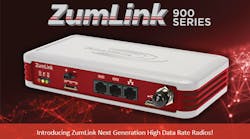This file type includes high resolution graphics and schematics when applicable.
Sensors everywhere: That’s one possible vision of the future, made all the more plausible with Internet of Things (IoT) devices providing the means to remotely control just about anything electronic. But getting the volume of data from these sensors to the internet for “anytime access” has long been the challenge—using available bandwidth to still achieve high-enough data rates to make all of that sensor data usable.
The answer may have just arrived in the form of the ZumLink 900 family of 900-MHz serial radios from FreeWave Technologies. With user-selectable transmit power, these radios can transmit data from Ethernet, USB, and RS-232 ports at high data rates (depending on serial interface) over line-of-sight (LOS) distances as far as 40 miles.
FreeWave, of course, made news earlier this year with the introduction of its dual-band WavePro WP201 radio solution, covering 2.4- and 5-GHz bands in one compact unit. The ZumLink 900 family of radios represents an addition to the company’s lines of radio products for its Sensor-2-Sensor (S2S) wireless access-layer strategy, to transfer voice, video, and data, including in machine-to-machine (M2M) and IoT applications.
According to Scott Allen, FreeWave’s CMO, “By combining amazing radio performance with an intelligent platform, ZumLink enables customers to tailor their IoT communications to whatever they need, commercial or industrial, and also provides the ability to develop custom software applications for their future technology requirements.”
The ZumLink 900 Series initially includes four platforms: two radio modules, a board-level radio that can be embedded into system designs, and a fully enclosed radio, all operating in the unlicensed 900-MHz radio band from 902 to 928 MHz. The Z9-T radio module incorporates transistor-transistor-logic (TTL) data interfaces, while the Z9-C radio module provides RS-232 interfaces.
The board-level Z9-PC radio features two Ethernet and two serial data ports, and the enclosed Z9-PE radio (see figure) includes a single Ethernet port and two serial ports. The firm offers numerous options with the radios to meet specific customer requirements.
The ZumLink radios all operate at 900 MHz with user-adjustable transmit power (which will affect the LOS range) from 10 mW to 1 W. Link data rates currently range from 115.2 kb/s to 4 Mb/s. Depending on the serial data connection to the radio, the radios can achieve link throughput as high as 850 kb/s with an RS-232 connection, and as high as 2 Mb/s with an Ethernet or TTL connection (at a link rate of 4 Mb/s).
The transmitters, which use Gaussian frequency shift keying (GFSK) and 8-ary FSK modulation, offer channel sizes of 115.2, 345.6, 691.2, 1382.4, and 3225.6 kHz. The radios employ frequency-hopping techniques to avoid the “RF clutter” created by the large number of wireless devices operating in the 900-MHz band, with as many as 111 frequency-hopping channels and up to 16 hopping patterns, at hopping rates of 25, 50, 100, 200, and 400 ms.
The receiver sensitivity is a function of RF data rate, with sensitivity of –106 dBm at 115.2 kb/s. With their modulation and hopping techniques, the radios achieve 136-dB system gain.
To preserve and protect data, the radios employ cyclical-redundancy-check (CRC), forward-error-correction (FEC), and automatic-repeat-request (ARQ) error correction and 128-b advanced-encryption-standard (AES) data encryption. They operate on supplies of +3 to +5 V dc with low current consumption: 1230 mA at +3 V dc and 680 mA at +5 V dc.
Each radio has built-in diagnostics capabilities and is designed for operating temperatures from −40 to +85°C. The modules each measure 2.0 × 1.4 × 0.3 in. With their flexibility and capabilities, especially the long LOS range, these radios can truly make “remote sensing” a reality.
FreeWave Technologies Inc., 5395 Pearl Pkwy., Ste. 100, Boulder, CO 80301; (866) 923-6168
This file type includes high resolution graphics and schematics when applicable.



